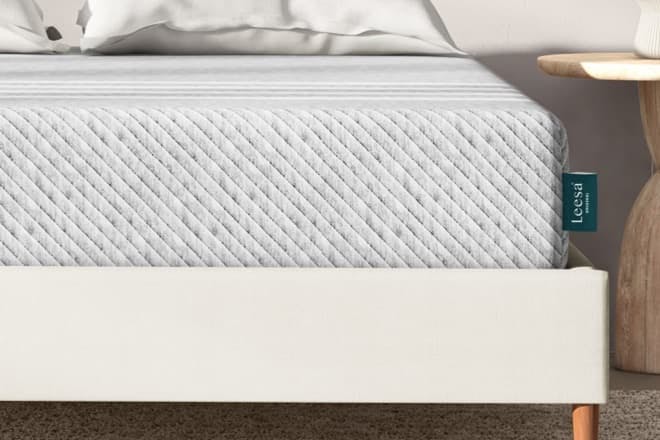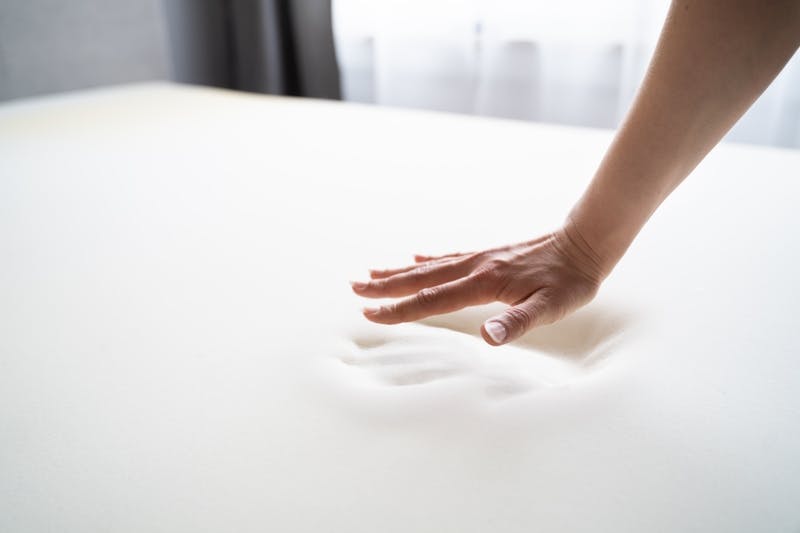Memory foam has been a popular mattress material for many years, and for good reason! But what is a memory foam mattress exactly? Why is it used in mattresses, and what benefits does it offer?
Today we will take a look at what memory foam is in detail, so you can fully understand the benefits of this incredible material. We’ll also show you how to choose the right memory foam mattress for your bedroom.
Getting to know this material will ultimately help you decide which type of mattress is right for you.
What is Memory Foam?
Memory foam is made of a plastic polymer called polyurethane. A polymer, in the simplest of terms, is any substance with very large molecules that consist of many small pieces bonded together.
One of the coolest things about memory foam is that it is “viscoelastic.” This means it reacts and softens when exposed to heat—for example, body heat! It also means that when it stretches and molds to a new position, it will still return to its original shape when the heat or force is removed.
What memory foam is precisely can vary from company to company. Different manufacturers of memory foam use different recipes and add different chemicals to the polyurethane to affect the feel and function of the foam.
What is memory foam used for?
Memory foam is used in a lot of everyday objects, from sofas and shoes to blankets and mattresses. But mattresses are undoubtedly what most people think of when they hear the term “memory foam.”
Let’s discuss what a memory foam mattress is, what sets it apart from other types of mattresses, and how it can benefit your sleep.
What is a Memory Foam Mattress?
A memory foam mattress is a mattress made with one or more layers of memory foam built into it. The mattress is not made completely out of memory foam, however, and there may be any number of other support and comfort layers built in.

From NASA to Leesa: a brief history of memory foam mattresses
1966: Memory foam was first developed by Charles Yost, an engineer working for NASA, to counteract the extreme pressure astronauts faced when exiting and entering the Earth's atmosphere.
1970s: Memory foam starts to be used in a variety of ways, including aircraft cushions, car seats, and medical equipment.
1991: Tempur-Pedic, a company founded by Norwegian engineer Peter Møller, introduces the first commercial memory foam mattress.
1990s-2000s: Memory foam mattresses become increasingly popular, and a number of other companies begin to manufacture and sell them.
2010s: Memory foam mattresses continue to grow in popularity and account for a significant share of the mattress market.
Now that you understand what memory foam is and where it came from, let’s discuss what sets a memory foam mattress apart from a traditional spring mattress.
What is the difference between a memory foam mattress and a spring mattress?
There are a few key differences between memory foam and traditional mattresses, including the materials used, the weight of the mattress, and the sinkage.
Materials
A memory foam mattress must include at least one layer of memory foam. It may also include springs or other supportive materials, and in this case, it would be called a hybrid mattress.
A traditional spring mattress contains many coiled springs topped by soft materials for added comfort.
Mattress weight
Memory foam mattresses tend to weigh more than traditional mattresses because what memory foam is made of is quite dense and heavy.
Sinkage
What is memory foam best known for? Molding to the shape of your body. That means sleepers will “sink” more into a memory foam mattress than a traditional spring mattress.
Besides comfortably conforming to the shape of your body, let’s take a look at some other reasons why memory foam mattresses are so popular.
Benefits of Memory Foam Mattresses
What is memory foam good for in mattresses? Here are just some of the benefits of memory foam mattresses.
Pressure and pain relief
One of the best things about a memory foam mattress is the pressure relief it provides, especially on your shoulders and hips. Memory foam adapts to your specific body shape while you sleep. So instead of being stuck in a valley or rolling over lumps while you sleep, your memory foam mattress will move with you, doing away with your aches and pains so you wake up well-rested. That’s a part of Leesa’s signature feel, which makes our beds great for any body shape and sleeping style.
Improved spinal alignment
Because memory foam provides superior support and adapts to your sleeping style, it will keep your spine and neck aligned while you sleep. If you’re tired of waking up with neck kinks and backaches, this probably sounds great to you. (That’s because it is.)
Motion isolation
Waking up every time your partner, child, or fur baby moves keeps you from getting the sleep you need. That’s another great thing about a memory foam mattress—there is little to no motion transfer.
Temperature regulation
Ever struggled to fall asleep from being too hot or too cold? Memory foam can help regulate your body temperature, which can help you fall asleep faster and stay asleep longer.
Hypoallergenic material
Thanks to the hypoallergenic nature of memory foam, a Leesa mattress is a great option if you have allergies. Memory foam has a naturally dense structure, so allergens are less likely to build up on it. This includes dust, mold, mildew, and mites.
High durability
Most memory foam mattresses last 7-10 years, which is longer on average than a spring mattress. That range can vary depending on your sleep habits and mattress care routine, but this longevity makes a memory foam mattress a wise investment.
Easy to care for
Memory foam mattresses are very easy to take care of. Just change your sheets weekly, and rotate your mattress 180 degrees every three to six months. (Don’t flip it upside down though, since memory foam mattresses are carefully layered to provide support in one direction only.)
You can also vacuum your mattress (with an upholstery attachment) or use a steam cleaner for a deep clean. Of course, if you want to prevent spills and stains in the first place, you can check out our waterproof mattress protector!!
Now that you know some of the wonderful benefits of memory foam mattresses, let’s talk about how to find the right mattress for you.
Considerations When Choosing a Memory Foam Mattress
When shopping for the perfect memory foam mattress, you should consider:
Heat retention
Some memory foam mattresses can retain heat, which can make them uncomfortable for some people. At Leesa, we said no more sweaty sleep—our mattresses are made with a premium cooling top layer of foam that was engineered to promote airflow while you snooze.
Odor
Some memory foam mattresses may have a strong odor when they are new. This odor will usually dissipate over time, but it’s worth considering if you are sensitive to smells. Make sure to read product reviews to see what people are saying about the smell of particular mattresses.
Cost
Memory foam mattresses tend to be more expensive than traditional mattresses. But they can also range from a few hundred dollars to several thousand dollars. Whatever your budget, you should be able to find a memory foam mattress you can afford.
If cost is a concern when it comes to memory foam mattresses, Leesa offers tpremium options that won’t break the bank. We even offer financing!! And don’t forget that paying for a higher-quality, longer-lasting mattress may save you money in the long run.
Your needs
What are your most important priorities in a mattress? Do you need a mattress that provides pressure relief, support, motion isolation, or temperature regulation?
The best way to find the right memory foam mattress for you is to try out different mattresses and see which one you prefer. To discover the ideal memory foam mattress, consider taking Leesa's sleep quiz for personalized recommendations. Additionally, you can experience Leesa mattresses firsthand at West Elm and Pottery Barn stores.

Ready to Get a Better Night’s Sleep?
Let Leesa help you upgrade your bed and get your best rest. We have a variety of comfortable all-foam and hybrid foam mattresses for you to choose from. Each model is designed with your comfort and budget in mind. Come find your perfect fit!

FAQs
What is memory foam made of?
Memory foam is made from elastic, high-density polyurethane. It can be mixed with other materials to affect its flexibility and temperature, such as tiny, cooling gel beads.
How does memory foam work?
Memory foam works by reacting to your body heat. When your memory foam mattress heats up, it will become soft enough to mold to your body shape. Then, when the pressure and heat are removed, it will return to its original shape.
Why is memory foam good for sleeping?
A memory foam mattress can help relieve joint pain. It can also encourage proper spinal alignment for a comfortable night’s sleep.
Are memory foam mattresses bad?
For some people, memory foam mattresses may retain too much body heat to be comfortable. Some gel-infused memory foam options are also pricey compared to spring mattresses. A Leesa mattress, however, is an affordable option that helps draw away body heat.
Does the memory foam smell go away?
Yes, the initial odor will go away quickly. Many memory foam mattresses emit odors, known as off-gassing, when they first come out of the package. These chemical smells come from very low levels of gasses coming off the foam.
What are Leesa mattresses made of?
At Leesa, we have two great mattresses that feature memory foam: the Leesa Original all-foam mattress and the Leesa Sapira Hybrid mattress. The Leesa Original mattress is a memory foam mattress with three layers of premium foam for body contouring and pressure relief, engineered to promote airflow and keep you cool all night long. The Leesa Sapira Hybrid mattress is a combination of premium foam support layers and individually wrapped springs for a luxurious feel. If you’re mattress shopping, we’re here to help. Start with our Mattress Buying Guide to find out what type of mattress is right for you.
Why is memory foam called memory foam?
Memory foam is named for its ability to "remember" its original shape after being compressed. This is due to its viscoelastic properties, which allow it to return to its original form when pressure is removed.
How does memory foam work?
Memory foam consists mainly of polyurethane with added chemicals that increase its viscosity and density. It responds to heat and pressure by molding the body's shape, distributing weight evenly. This contouring effect reduces pressure points, improves circulation, and provides personalized support for better sleep quality.
Are memory foam mattresses good?
Memory foam responds to body heat, molding to your shape, and evenly distributing weight, which can result in better sleep quality and reduced pain.
Are memory foam mattresses hot?
Memory foam mattresses may retain heat, which can lead to discomfort for some individuals. However, advancements in mattress technology, such as gel-infused foam and breathable covers, aim to mitigate heat retention and promote airflow for a cooler sleeping experience. While some users may still find memory foam mattresses to be too warm, others may not experience significant heat buildup, depending on personal preferences and environmental factors. It's essential to consider factors like room temperature and mattress accessories when determining the overall comfort of a memory foam mattress.



